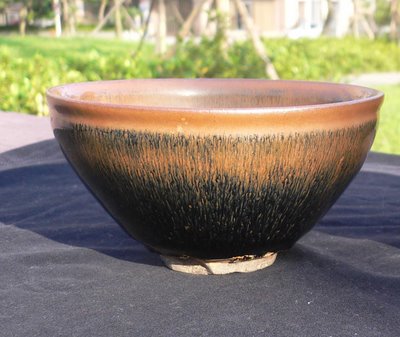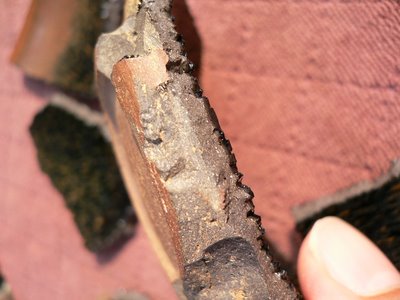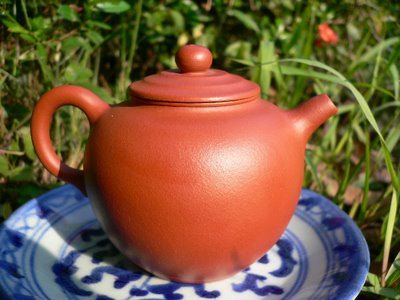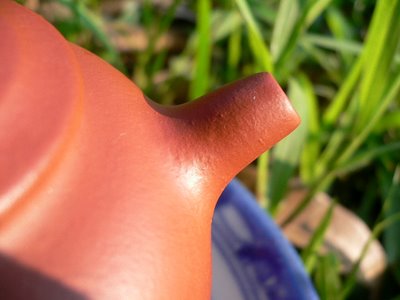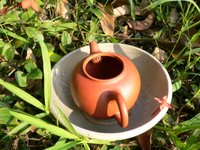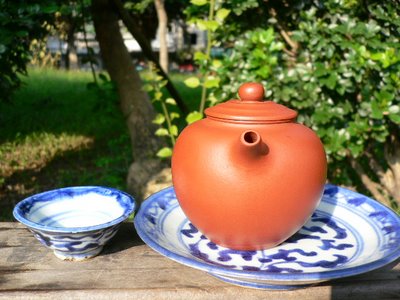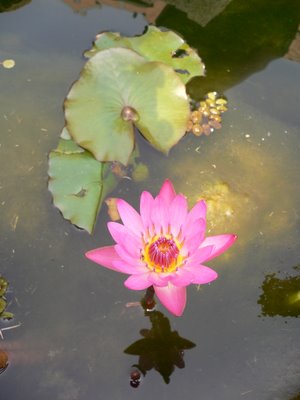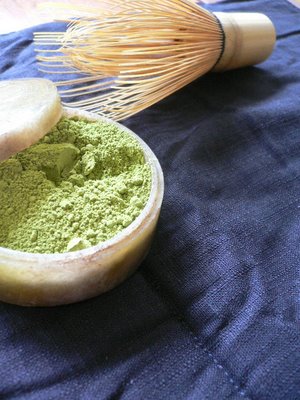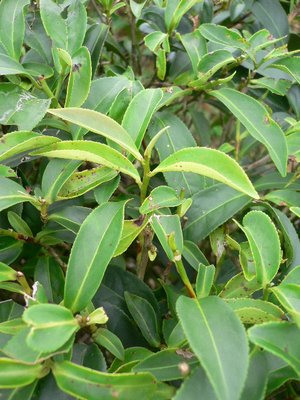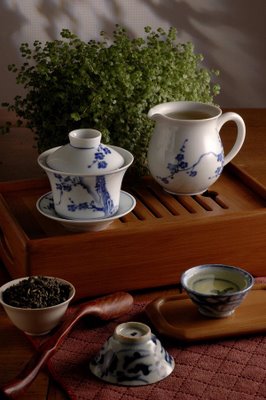Below are my tasting notes for 6 samples Blake from Yahoo!'s Tea-Disc has sent me (and 14 other participants). The 5 Wu Yi and 1 Taiwan Shui Xian samples all come from American retailers. I will keep their names quiet, because I don't want you to think I'm doing this just to criticize potential competitors. (For the curious, you can check
Kim's and
Kevin's tasting notes to compare with mine -and get the vendors' names). The teas are displayed in order from A to F from left to right:
 Let's first start with the tools and method:
Let's first start with the tools and method:1. Warming of the competition tasting cup and bowl
2. Tea: 2-3 grams (I put one thin layer in the cup, using my sight to make the weight even)
3. Shortly boiled Volvic water in my iron tetsubin to brew all teas at the same time for 2 minutes.
4. I also use a Chinese soup spoon (plunged in hot water) to smell the tea (on the back of the spoon) and to drink a sip.
5. The dry leaves that remain come on the round white porcelain plate to be smelled.
Below a view from F, in front to A, behind.

A. Taiwan Shui Xian
Dry leaves:Rolled. Smell like fish, seaweed.
Spoon and cover smells:classic, roasted Taiwan oolong, nicely sweet
Tea soup clarity:OK
Taste:Warm, the mellow is stronger than the astringency. But a little dull.
Wet leaves:Huge hand harvested leaves. Such big leaves without buds show that these are older, lower quality leaves.
The roasting was OK and got the most out of these leaves. I almost liked it, probably because this Taiwan Oolong does taste more familiar than the Wu Yis I rarely drink.
B. Organic Wu Yi
Dry leaves:Long, but many are broken. Smell like honey, interesting complexity.
Spoon and cover smells:Pepper, astringency, reminds me of cheap raw puerh. Excessive or bad roasting
Tea soup clarity:Good: it's a little shiny
Taste:A little like red tea, sweet/sour. The tea is quite complex and tastes almost good.
Wet leaves:Machine cut. After a second brew, the leaves would disintegrate between my fingers: real organic leaves are usually stronger as only the strong leaves survive.
This tea is the only one I felt like brewing a second time (2 minutes again). The first brews had these back and forth between acidity, sweetness, fruit and honey that made it a little interesting. But there was not much more to get in the second brew.
C. Da Hong Pao
Dry leaves:Dark to green, long unbroken leaves. Light honey
Spoon and cover smells:Light honey and light sweetness
Tea soup clarity:Average
Taste:Few defects, but nothing outstanding either. There is a faint charming note of sweet honey.
Wet leaves:Uneven oxidation of the leaves. Some are red, some are green. Machine cut.
A tree that doesn't live up to its name.

D. Traditional Da Hong Pao
Dry leaves:Dark to red, long unbroken leaves. Burnt licorice
Spoon and cover smells:Pepper and cigarette butt. Charcoaled rubber. I start to feel bad already.
Tea soup clarity:Average
Taste:Horrible cigarette butt. I can feel how it irritates my stomach.
Wet leaves:Long whole leaves. I doubt they are from spring. Probably summer to be so bad.
On a positive note, you could use this tea if you have trouble digesting and are constipated. I had a nice sh.. after that. You could also prepare a cup to your best foe in the office just before his annual evaluation meeting!
E. Rou Gui
Dry leaves:open, short leaves. (Can't read my handwriting)
Spoon and cover smells:Smell like low quality lightly roasted Baozhong
Tea soup clarity:Below average
Taste:A hint of fresh oolong, not too much astringency.
Wet leaves:Machine cut. Mostly green and a little red.
Reminds me of the cheapest Dong Ding Oolong from a famous tea shop in Taipei.
F. Tieh Luo Han
Dry leaves:Smaller open leaves. Pepper smell.
Spoon and cover smells:Some sweetness. OK.
Tea soup clarity:OK
Taste:Very much like a red tea. Sweet and sour.
Wet leaves:Green and red broken leaves
This is way below Oriental Beauty/Bai Hao Oolong in terms of strength, finesse or complexity. Not bad, but really nothing to get excited about.

I didn't drink tea on Monday, so I was really thirsty for tea today (despite the 31 degrees Celcius in my living room). So, to close this tasting on a nicer note, I remembered that I have a
Wu Yi Shui Xian in my selection. I tend to forget it, since it's also one that few people order. I even wonder if it's because it's so cheap (less than 0,1 USD per gram). So, I put a few gram in a competition cup and used the same water and the same brewing parameters.
The difference was striking! That's what I call roasting! A very full roast, not something that leaves the tea between two worlds green and dark. And I also realize that there is an adjective I didn't use for the 6 samples: long! This tea has a long and sweet aftertaste. Humm.
My Shui Xian is not a complex, delicate kind of tea. I would lie if I implied that. But it has strength and delivers a warm, mellow cup of honey, nuts and ripe fruit.
I was even able to make a second (equally good) and third brew (starting to fade) with 2 and 3 minutes additional brewing times.
Further, I think it's also a good time to announce that I have decided to add the tea competition accessory (1 cup with cover, 1 cup to put the tea and the display plate) in my selection. I think it's a great tool to evaluate the quality of tea and look for defects. If you have a gaiwan, you may not absolutely need it, but if you want to evaluate several teas side by side, then the best is to use the same standard tool as professionals.
It's price: 9 Euros or 10,95 USD, without transportation.
 Teaparker nous a rappelé que le nom exact du bol noir dans lequel on fait le thé vert en poudre à la manière de la dynastie Sung n'est pas Tian Mu. Ce nom est le nom d'usage au Japon (tenmoku) et provient du fait que des voyageurs japonais ont découvert ce bol chez les moines bouddhistes du Mont Tian Mu, en Chine. Pour eux, ensuite, c'est cette origine qui est resté. Mais le bol ne viennait pas du Mont Tian Mu, mais bien de la ville de Jianyang (j'avais écrit zhen yang dans un article précédent) dans le nord de la région du Fujian. Le nom précis est donc: 'hei yo Jian zan' ou bol en porcelaine noire de Jianyang.
Teaparker nous a rappelé que le nom exact du bol noir dans lequel on fait le thé vert en poudre à la manière de la dynastie Sung n'est pas Tian Mu. Ce nom est le nom d'usage au Japon (tenmoku) et provient du fait que des voyageurs japonais ont découvert ce bol chez les moines bouddhistes du Mont Tian Mu, en Chine. Pour eux, ensuite, c'est cette origine qui est resté. Mais le bol ne viennait pas du Mont Tian Mu, mais bien de la ville de Jianyang (j'avais écrit zhen yang dans un article précédent) dans le nord de la région du Fujian. Le nom précis est donc: 'hei yo Jian zan' ou bol en porcelaine noire de Jianyang. 






